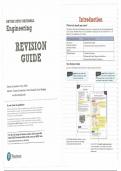Summary
Summary Unit 1 engineering principles Revision Guide 2
- Course
- Institution
Unit 1 engineering principles Revision Guide 2 includes clear worked examples of engineering principles questions from Pass, Merit, and Distinction Criteria. This document will most likely assist you to achieve your best in the exam and in the weekly assignments.
[Show more]



